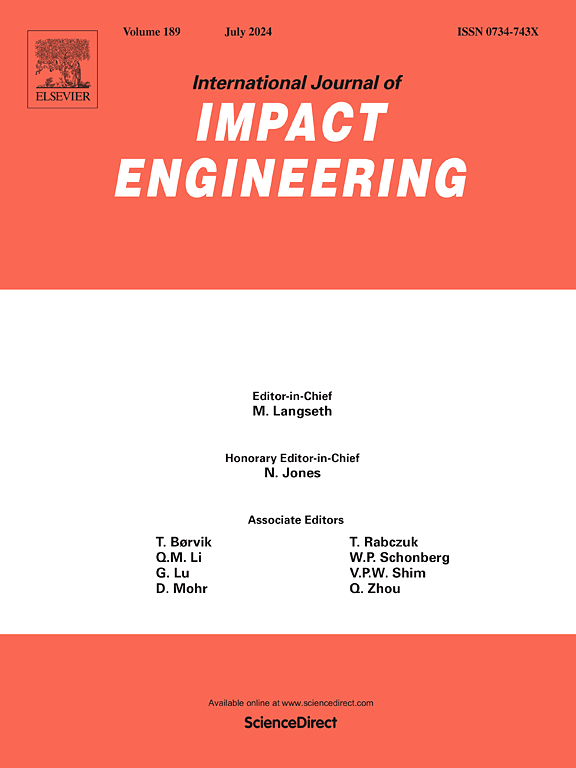Deformation mechanisms and energy absorption characteristics of 3D-printed negative poisson's ratio sandwich structures subjected to underwater impulsive loading
IF 5.1
2区 工程技术
Q1 ENGINEERING, MECHANICAL
International Journal of Impact Engineering
Pub Date : 2025-04-04
DOI:10.1016/j.ijimpeng.2025.105355
引用次数: 0
Abstract
Negative Poisson's ratio (NPR) structures are known for their superior mechanical properties and energy absorption capabilities, yet research on their resilience against underwater explosions remains limited. In this study, two types of NPR sandwich structures were designed: a coaxial re-entrant honeycomb sandwich structure (S-CRHS) and a non-coaxial re-entrant honeycomb structure (S-NRHS). Specimens, both heat-treated and non-heat-treated, were fabricated using 3D printing technology. The deformation mechanisms and energy absorption capacities of these structures under various intensities of underwater impact loads were investigated using experimental and numerical approaches. The underwater shock wave, which decays exponentially, was generated by a fly plate striking a diffusion-type fluid–solid interaction experimental apparatus. High-speed cameras, integrated with three-dimensional digital image correlation technology (3D-DIC), recorded the real-time deformation of the back panels. The impact process was also simulated using the coupled Eulerian–Lagrangian method in Abaqus/Explicit, with the numerical results showing good agreement with experimental data. The findings revealed that S-CRHS displayed symmetric deformation patterns and a linear relationship between dimensionless impulse and displacement, indicative of stability. In contrast, the asymmetrical design of S-NRHS resulted in varied deformation modes and energy absorption characteristics, with a notable NPR effect leading to a nonlinear relationship between dimensionless impulse and dimensionless displacement, characterized by three phases and two critical strength transition points. When compared to S-CRHS, the S-NRHS core demonstrated enhanced energy absorption capabilities, showing superior impact resistance when the non-dimensional impulse was below 0.0503. Additionally, heat treatment significantly improved the toughness of the 3D-printed materials and reduced cell wall fractures. This research provides valuable insights into the potential applications of NPR structures in underwater protection scenarios.
水下脉冲载荷作用下3d打印负泊松比夹层结构变形机理及吸能特性
负泊松比(NPR)结构以其优越的力学性能和能量吸收能力而闻名,但对其抗水下爆炸弹性的研究仍然有限。本研究设计了两种非同轴重入蜂窝夹层结构,即同轴重入蜂窝夹层结构(S-CRHS)和非同轴重入蜂窝结构(S-NRHS)。采用3D打印技术制作热处理和非热处理的样品。采用实验和数值方法研究了这些结构在不同强度水下冲击载荷作用下的变形机理和吸能能力。用飞板撞击扩散型流固相互作用实验装置,产生指数衰减的水下激波。高速摄像机与三维数字图像相关技术(3D-DIC)相结合,记录了后面板的实时变形。在Abaqus/Explicit中采用欧拉-拉格朗日耦合方法对冲击过程进行了数值模拟,数值结果与实验数据吻合较好。结果表明,S-CRHS具有对称的变形模式,且无量纲脉冲与位移之间呈线性关系,表明其具有稳定性。非对称设计导致S-NRHS的变形模式和能量吸收特性发生变化,其中显著的NPR效应导致无量纲冲击和无量纲位移之间存在非线性关系,表现为三个阶段和两个临界强度过渡点。与S-CRHS相比,S-NRHS核心的能量吸收能力增强,当无量纲冲量小于0.0503时,其抗冲击能力更强。此外,热处理显著提高了3d打印材料的韧性,减少了细胞壁断裂。该研究为NPR结构在水下保护场景中的潜在应用提供了有价值的见解。
本文章由计算机程序翻译,如有差异,请以英文原文为准。
求助全文
约1分钟内获得全文
求助全文
来源期刊

International Journal of Impact Engineering
工程技术-工程:机械
CiteScore
8.70
自引率
13.70%
发文量
241
审稿时长
52 days
期刊介绍:
The International Journal of Impact Engineering, established in 1983 publishes original research findings related to the response of structures, components and materials subjected to impact, blast and high-rate loading. Areas relevant to the journal encompass the following general topics and those associated with them:
-Behaviour and failure of structures and materials under impact and blast loading
-Systems for protection and absorption of impact and blast loading
-Terminal ballistics
-Dynamic behaviour and failure of materials including plasticity and fracture
-Stress waves
-Structural crashworthiness
-High-rate mechanical and forming processes
-Impact, blast and high-rate loading/measurement techniques and their applications
 求助内容:
求助内容: 应助结果提醒方式:
应助结果提醒方式:


